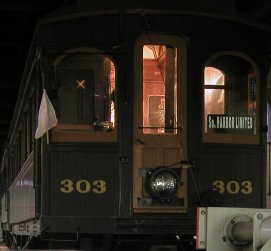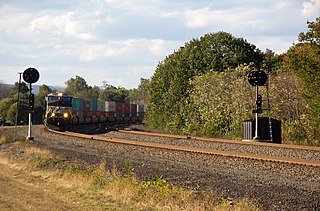The Pennsylvania Railroad, legal name The Pennsylvania Railroad Company, also known as the "Pennsy", was an American Class I railroad that was established in 1846 and headquartered in Philadelphia. It was named for the commonwealth in which it was established. At its peak in 1882, the Pennsylvania Railroad was the largest railroad, the largest transportation enterprise, and the largest corporation in the world.

Bailey Yard is the world's largest railroad classification yard. Employees sort, service and repair locomotives and cars headed all across North America. Owned and operated by the Union Pacific Railroad (UP), Bailey Yard is located in North Platte, Nebraska. The yard is named after former Union Pacific president Edd H. Bailey.

The Raritan River Rail Road was a 12-mile (19 km) shortline railroad in Middlesex County, New Jersey U.S., Founded in 1888, it was based in South Amboy, from which it ran west as far as New Brunswick. It served both passengers and freight in its heyday and operated profitably throughout much of its existence. The Raritan River was absorbed into Conrail in 1980, becoming a branch line of Conrail Shared Assets Operations. It terminates at U.S. Route 1 in North Brunswick.

The Keystone Corridor is a 349-mile (562 km) railroad corridor between Philadelphia and Pittsburgh, Pennsylvania, that consists of two rail lines: Amtrak and SEPTA's Philadelphia-to-Harrisburg main line, which hosts SEPTA's Paoli/Thorndale Line commuter rail service, and Amtrak's Keystone Service and Pennsylvanian inter-city trains; and the Norfolk Southern Pittsburgh Line. The corridor was originally the Main Line of the Pennsylvania Railroad.

The Gallitzin Tunnels in Gallitzin, Pennsylvania, are a set of three adjacent tunnels through the Allegheny Mountains in western Pennsylvania. They were completed in 1854, 1855, and 1902 by the Pennsylvania Railroad as part of the cross-state route that includes the nearby Horseshoe Curve to the east. Their ownership has since passed to Penn Central Transportation Company, then to Conrail, and most recently to the Norfolk Southern Railway. The tunnels are currently used by Norfolk Southern freight trains and Amtrak Pennsylvanian passenger trains.

Pavonia Yard is a Conrail Shared Assets Operations (CSAO) rail yard in Camden, New Jersey.

Cleveland has been and continues to be deeply rooted in railroad history.

The Lurgan Branch is a railroad line owned and operated by the Norfolk Southern Railway in the U.S. states of Pennsylvania and Maryland. The line is part of the NS Harrisburg Division and runs from Harrisburg, Pennsylvania southwest to Hagerstown, Maryland along former Reading Company and Pennsylvania Railroad lines. Its northeast end is at a junction with the Harrisburg Line, Pittsburgh Line, Royalton Branch, and Amtrak's Keystone Corridor ; its southwest end is at the beginning of the Hagerstown District. At Lemoyne it intersects the Enola Branch.
The Delaware Extension was a rail line owned and operated by the Pennsylvania Railroad in Philadelphia, Pennsylvania.
The Shellpot Branch is a former Pennsylvania Railroad/Penn Central through-freight railroad owned and operated by Norfolk Southern since its acquisition, along with CSX Transportation, of Conrail in 1999. The branch allows Norfolk Southern, since the opening of a new bridge in 2001, to bypass the city of Wilmington, Delaware and allows direct access to both the Port of Wilmington and the New Castle Secondary, which connects to the Delmarva Subdivision of the Delmarva Central Railroad that runs to Central Delaware, Maryland, and Virginia's Eastern Shore. Both ends of the branch connect with Amtrak's Northeast Corridor and, like all of the PRR's through-freight lines, was electrified from 1935 until the Conrail era. The line was originally built doubly tracked, but was subsequently converted to single track.

Pennsylvania Railroad 4859 is a GG1-class electric locomotive located in the Harrisburg Transportation Center in Harrisburg in the U.S. state of Pennsylvania. It was operated by the Pennsylvania Railroad and its successors, Penn Central and Conrail. 4859 pulled the first electrically powered train from Philadelphia to Harrisburg on January 15, 1938. It was used in various freight and passenger service until November 22, 1979, when it pulled the last GG1-powered freight train on November 22, 1979. Originally located in Strasburg, it was listed on the National Register of Historic Places in 1982 and was moved to its current location in 1986. It was designated the state electric locomotive of Pennsylvania in 1987 by the Pennsylvania General Assembly and was re-listed on the National Register of Historic Places in 2004.
Rutherford Intermodal Yard is a large rail yard located in Swatara Township, Dauphin County, just east of Harrisburg, Pennsylvania.

The Atglen and Susquehanna Branch is an abandoned branch line of the Pennsylvania Railroad that ran between Lemoyne and Atglen, Pennsylvania. A portion of the line is now the Enola Low Grade Trail.

Selkirk Yard is a large freight railroad yard located in Selkirk, New York, about 8 mi (13 km) south of Albany. The yard is owned by CSX Transportation and is its major classification yard for the northeastern United States and the gateway to points east of the Hudson River, including New York City. It is situated just west of the Alfred H. Smith Memorial Bridge on the railroad's Castleton Subdivision, and is the eastern end of the Selkirk Subdivision.

The Pittsburgh Line is the Norfolk Southern Railway's primary east–west artery in its Pittsburgh Division and Harrisburg Division across the U.S. state of Pennsylvania and is part of the Keystone Corridor, Amtrak-Norfolk Southern's combined rail corridor.
Conway Yard is a major rail yard located in the boroughs of Conway, Pennsylvania, and Freedom, Pennsylvania, 22 miles (35 km) northwest of Pittsburgh, Pennsylvania, along the Ohio River. It was the largest freight yard in the world from 1956 until 1980. It is currently owned by Norfolk Southern (NS) and is one of the largest yards in the United States and on the east coast.

The Trenton Cutoff is a 48-mile (77 km) rail corridor in the U.S. state of Pennsylvania that runs from Morrisville to Glenloch. Today used by Norfolk Southern, it consists of two rail lines: the Morrisville Line, which runs between Morrisville and Ernest, and the Dale Secondary between Ernest and Glenloch.

The Lehigh Line is a railroad line in Central New Jersey, Northeastern Pennsylvania, and the Lehigh Valley region of eastern Pennsylvania. It is owned and operated by the Norfolk Southern Railway. The line runs west from the vicinity of the Port of New York and New Jersey in Manville, New Jersey via Conrail's Lehigh Line to the southern end of Wyoming Valley's Coal Region in Lehigh Township, Pennsylvania.

Cedar Hill Yard is a classification yard located in New Haven, North Haven and Hamden, Connecticut, United States. It was built by the New York, New Haven and Hartford Railroad in the early 1890s in and around New Haven's Cedar Hill neighborhood, which gave the yard its name. Electrical catenary for electric locomotives was added to the yard in 1915. To handle increasing traffic as a result of World War I, the yard was greatly expanded between 1917 and 1920 with additional construction along both sides of the Quinnipiac River. The construction project added two humps where railroad cars were sorted into trains by gravity. The yard was further modernized in the 1920s, becoming one of the busiest railroad yards in the United States, and the most important yard in the entire New Haven Railroad system.

Northup Avenue Yard is a rail yard located in Providence and Pawtucket, Rhode Island, in the United States. The location has been the site of a rail yard since at least 1899. It was significantly expanded by the New York, New Haven and Hartford Railroad between 1918 and 1921 and made into a hump yard. The hump was removed around 1970, after Penn Central Transportation Company took over the New Haven in 1969. Under Penn Central, the yard was downsized and the hump removed. Conrail superseded Penn Central in 1976 and sold off the yard to the Providence and Worcester Railroad in 1982.
















